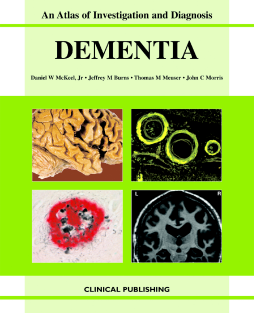
BOOK
Dementia: an Atlas of Investigation and Diagnosis
DW McKeel, J Burns, TM Meuser, JC Morris
(2007)
Additional Information
Book Details
Abstract
This thoughtful new work begins by asking the question ‘what is normal in cognitive and pathological ageing?’ The clinician’s experience of dementia and mild cognitive impairment suggests that these conditions present in a variety of forms and progress at different rates, with a spectrum of disability ranging from a barely perceptible loss of mental acuity to the severe debilitation of advanced Alzheimer’s disease. This atlas utilises diagnostic imaging, histopathological findings, schematic diagrams and other graphics to illustrate the symptom profiles, etiology, and epidemiology of the more common dementias. The authors present comparisons of Alzheimer’s and Lewy body disease, frontal temporal and vascular dementias and other dementing illnesses, to illustrate the problems inherent in distinguishing between them, and in making a diagnosis.
Table of Contents
| Section Title | Page | Action | Price |
|---|---|---|---|
| PREFACE Vll | |||
| ACKNOWLEDGEMENTS ix | |||
| INTRODUCTION xi | |||
| One: Rural industrialization | |||
| Identifying a strategy for small-scale rural | |||
| industrialization 1 | |||
| The blacksmiths of Manie, Zaire 3 | |||
| In-house shortcomings restraining informal | |||
| industrialization 12 | |||
| Resource deficiencies which restrain informal | |||
| industrialization 15 | |||
| Rural industrial viability 19 | |||
| Industrial origins: traditional or implanted? 21 | |||
| Two: Rural workshops | |||
| The comparative viability of urban and rural informal | |||
| manufacturing 25 | |||
| The significance of innovation 31 | |||
| Sustainability and growth 35 | |||
| Form of design input required by primary and | |||
| secondary workshops 39 | |||
| The comparative viability of primary and secondary | |||
| workshops 46 | |||
| Categorization of small workshop production in | |||
| developing countries 47 | |||
| Three: Relevance and ignorance | |||
| The contribution of the small workshop 52 | |||
| The relevance of the small workshop within | |||
| African development 55 | |||
| The failure of interventions 60 | |||
| Perception of success 67 | |||
| Four: Artisan-orientated intervention | |||
| The recognition of indigenous technical'knowledge 77 | |||
| The control of interventions 81 | |||
| Respectful collaboration 85 | |||
| External agents 99 | |||
| Clients and targets 102 | |||
| Success indicators 104 | |||
| Five: The way forward | |||
| The manner of interventions 108 | |||
| Approach to training 114 | |||
| Implications for intervention agents 120 | |||
| BIBLIOGRAPHY 127 |
